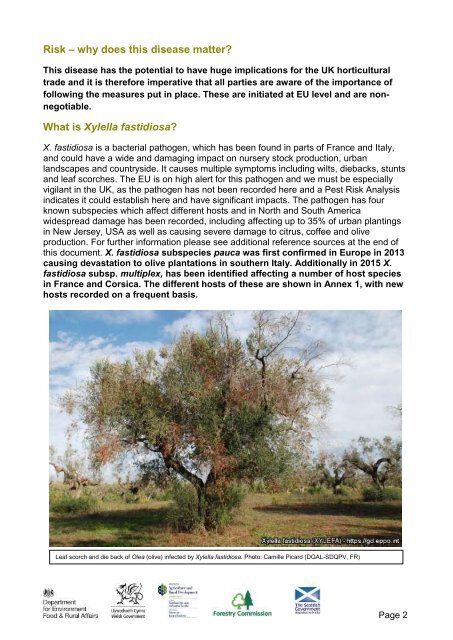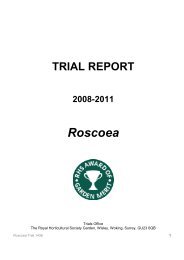Xylella fastidiosa
xylella-fastidiosa-impl-trade
xylella-fastidiosa-impl-trade
Create successful ePaper yourself
Turn your PDF publications into a flip-book with our unique Google optimized e-Paper software.
Risk – why does this disease matter?<br />
This disease has the potential to have huge implications for the UK horticultural<br />
trade and it is therefore imperative that all parties are aware of the importance of<br />
following the measures put in place. These are initiated at EU level and are nonnegotiable.<br />
What is <strong>Xylella</strong> <strong>fastidiosa</strong>?<br />
X. <strong>fastidiosa</strong> is a bacterial pathogen, which has been found in parts of France and Italy,<br />
and could have a wide and damaging impact on nursery stock production, urban<br />
landscapes and countryside. It causes multiple symptoms including wilts, diebacks, stunts<br />
and leaf scorches. The EU is on high alert for this pathogen and we must be especially<br />
vigilant in the UK, as the pathogen has not been recorded here and a Pest Risk Analysis<br />
indicates it could establish here and have significant impacts. The pathogen has four<br />
known subspecies which affect different hosts and in North and South America<br />
widespread damage has been recorded, including affecting up to 35% of urban plantings<br />
in New Jersey, USA as well as causing severe damage to citrus, coffee and olive<br />
production. For further information please see additional reference sources at the end of<br />
this document. X. <strong>fastidiosa</strong> subspecies pauca was first confirmed in Europe in 2013<br />
causing devastation to olive plantations in southern Italy. Additionally in 2015 X.<br />
<strong>fastidiosa</strong> subsp. multiplex, has been identified affecting a number of host species<br />
in France and Corsica. The different hosts of these are shown in Annex 1, with new<br />
hosts recorded on a frequent basis.<br />
Leaf scorch and die back of Olea (olive) infected by <strong>Xylella</strong> <strong>fastidiosa</strong>. Photo: Camille Picard (DGAL-SDQPV, FR)<br />
Page 2



